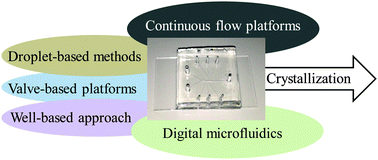Microfluidic platforms: a mainstream technology for the preparation of crystals
Abstract
Microfluidics is a multidisciplinary field of science based on the manipulation of fluids in sub-millimeter dimensions where the fundamental fluid physics changes dramatically when compared to macroscale fluid physical phenomena. Therefore, the conditions that microfluidic technologies offer are completely different from those of bulk set-ups, and thus they are very interesting for the study of crystallisation because diffusion, mixing and mass and heat transport are all finely controlled, and are easily modulated. This tutorial review is intended to give a broad and up-to-date overview of the distinct microfluidic approaches that have been employed so far for crystallisation studies for the uninitiated in these techniques. Main emphasis will be given to microfluidic platforms operating under continuous flow regimes, droplet-based methods, valve-based approaches, well-based methods, and digital microfluidics. This tutorial does not intend to give detailed methodology, but rather provides illustrative examples which capture the attention of the reader and allow them to appreciate the unique features that microfluidic technologies can offer towards the study of different crystallisation processes. Indeed, crystallisation studies of different types of crystalline matter including organic, inorganic and metal–organic materials are presented.

- This article is part of the themed collection: Nucleation and crystallisation

 Please wait while we load your content...
Please wait while we load your content...